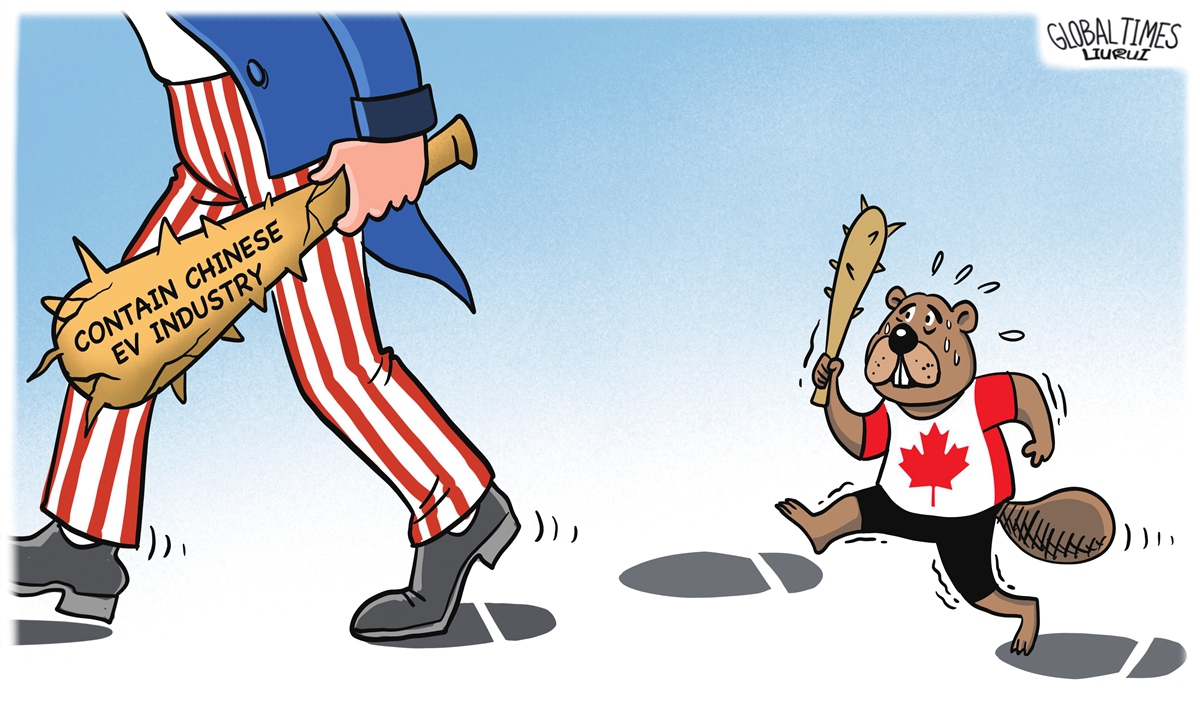
Following the wrong lead. Illustration: Liu Rui/GT
Canada's recent hardline approach to economic and trade relations with China, fueled by short-sighted and speculative geopolitical calculations, is unlikely to yield any additional benefits in its trade with the US and may even jeopardize the prospects for economic cooperation with China.
Canadian Deputy Prime Minister Chrystia Freeland on Wednesday highlighted her country's tougher approach to Chinese exports, which Bloomberg said signals that Canadian officials will try to make the case that they are aligned with a number of key US goals, including its strategy for competing with China.
In September, Freeland also said she is "absolutely" considering following the US move to ban vehicle hardware and software from China or Russia, according to Reuters.
It is not uncommon to see Canada adopting a tough stance on trade issues concerning China, especially in recent months.
In late August, following the lead of the US, Canada announced plans to impose a 100 percent tariff on imports of Chinese electric vehicles and a 25 percent tariff on imported steel and aluminum from China.
Western media outlets often interpret Canada's tough stance toward China as an effort to align closely with the US. Against the backdrop of the US viewing China as a strategic competitor, Canada aims to showcase its alignment in international economic affairs by following in the footsteps of the US, so as to strengthen political and economic ties between the two countries.
However, as it stands, the Canadian-style alignment doesn't necessarily empower Ottawa with any initiative or leverage its dealings with the US. Instead, it actually underscores Canada's vulnerability in US-Canada trade relations, revealing a dependency that has limited Canada's ability to assert its own interests in the face of American economic and trade policies.
In this context, following the US in targeting China as a strategic competitor is a completely misguided choice for Canada. This strategy not only undermines Canada's trade relationship with China but also renders Canada more passive in global trade. Canada needs to recognize that cooperation with China is crucial for its economic diversification and growth.
As one of the largest and most dynamic markets in the world, China offers vast opportunities that Canadian exporters simply cannot afford to overlook.
The trade relationship between Canada and China should be grounded in the principles of equality, mutual benefit and win-win cooperation, which can lead to enhanced economic ties and shared prosperity.
However, by seeking psychological comfort or political leverage in its trade with the US at the expense of its relationship with China, Canada is making a strategically unwise choice.
The more Canada seeks so-called favor or special treatment in its trade relations with the US, the more vulnerable it may become due to its excessive reliance on its southern neighbor.
This heavy dependence has not only constrained Canada's economic development but has also limited its ability to pursue independent trade strategies and diversify its economic partnerships.
If Canada aims to enhance its bargaining power and influence in trade relations with the US, targeting China as a strategic competitor may be the least effective approach.
The key to Canada's economic development lies in charting a course that aligns more closely with its own interests, reducing its heavy dependence on the US.
As an independent nation, Canada needs to establish its own foreign policy and economic development strategy. This involves formulating trade policies that reflect its unique resource endowments, industrial structure and developmental needs, rather than merely following the lead of the US.
Indeed, Canada could be better off by positioning itself as a proactive player in the global economy, adopting a balanced approach that fosters collaboration with China while simultaneously engaging constructively with the US.




